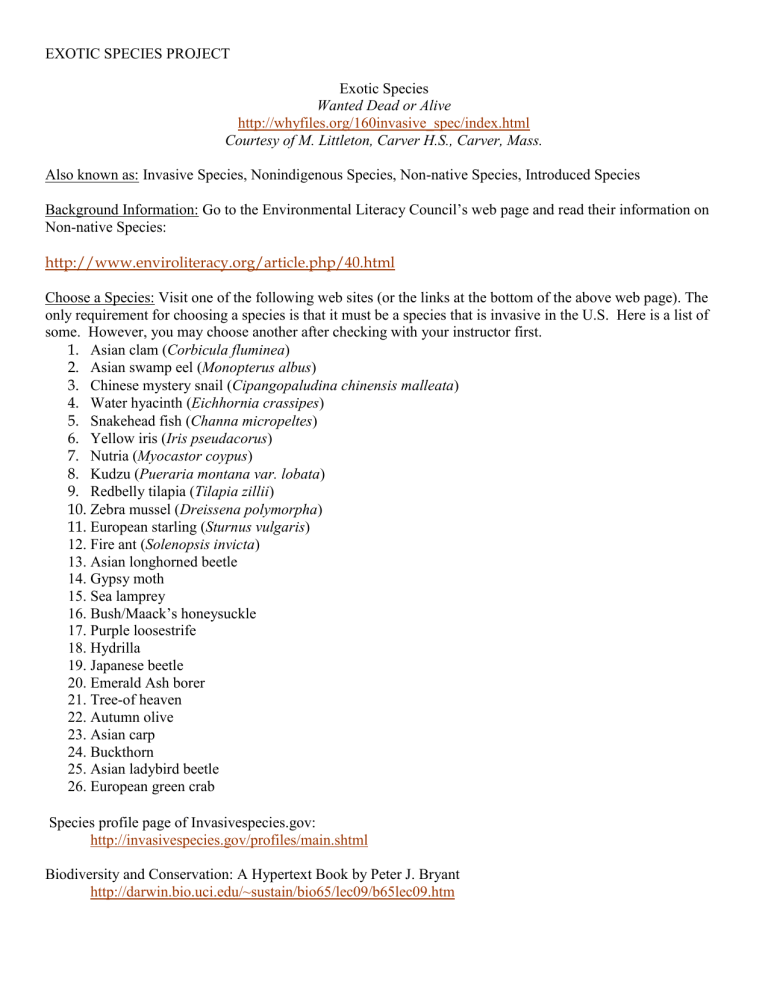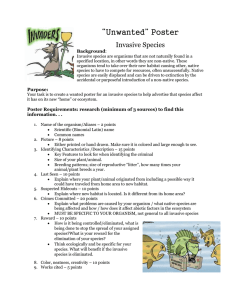
EXOTIC SPECIES PROJECT Exotic Species Wanted Dead or Alive http://whyfiles.org/160invasive_spec/index.html Courtesy of M. Littleton, Carver H.S., Carver, Mass. Also known as: Invasive Species, Nonindigenous Species, Non-native Species, Introduced Species Background Information: Go to the Environmental Literacy Council’s web page and read their information on Non-native Species: http://www.enviroliteracy.org/article.php/40.html Choose a Species: Visit one of the following web sites (or the links at the bottom of the above web page). The only requirement for choosing a species is that it must be a species that is invasive in the U.S. Here is a list of some. However, you may choose another after checking with your instructor first. 1. Asian clam (Corbicula fluminea) 2. Asian swamp eel (Monopterus albus) 3. Chinese mystery snail (Cipangopaludina chinensis malleata) 4. Water hyacinth (Eichhornia crassipes) 5. Snakehead fish (Channa micropeltes) 6. Yellow iris (Iris pseudacorus) 7. Nutria (Myocastor coypus) 8. Kudzu (Pueraria montana var. lobata) 9. Redbelly tilapia (Tilapia zillii) 10. Zebra mussel (Dreissena polymorpha) 11. European starling (Sturnus vulgaris) 12. Fire ant (Solenopsis invicta) 13. Asian longhorned beetle 14. Gypsy moth 15. Sea lamprey 16. Bush/Maack’s honeysuckle 17. Purple loosestrife 18. Hydrilla 19. Japanese beetle 20. Emerald Ash borer 21. Tree-of heaven 22. Autumn olive 23. Asian carp 24. Buckthorn 25. Asian ladybird beetle 26. European green crab Species profile page of Invasivespecies.gov: http://invasivespecies.gov/profiles/main.shtml Biodiversity and Conservation: A Hypertext Book by Peter J. Bryant http://darwin.bio.uci.edu/~sustain/bio65/lec09/b65lec09.htm Research: Obtain more information on your species by doing a web search. Be sure to document your sources. (title and address of all web pages used – put these on back of your poster) The product: 1. 1. A “Wanted” poster for your species. You must include: NAME / ALSO KNOWN AS (latin name / common name / “criminal” name) PICTURE – a drawing or photograph (color would be nice) IDENTIFYING CHARACTERISTICS – key features to look for when identifying the criminal LAST SEEN – where did the species originally come from? include a map. SUSPECTED HIDEOUTS - include a map of the U.S. with its current distribution shaded; description of preferred habitat CRIMES COMMITTED by your species (crimes must be specific to your species and not general to all invasive species) REWARD for elimination of your species (think ecologically, economically, socially, politically – again, be specific for your species) Color, neatness, and creativity 2. 2. Bibliography -- list of internet sites /web addresses OR appropriate bibliographic information 3. 3. Presentation - you will share the information on your species with the class in a brief oral presentation (2-3 minutes). The presentation component will be graded on the following: explanation of all the information on your poster in more detail than poster allows introduction history (where it came from and how it got here) methods of control Submission of Final Product Can Be Hard Copy or Electronically


